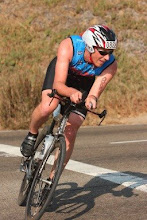First, if you are using a power meter on your bike you need to stop reading this blog and start reading Training and Racing with a Power Meter
There are a million details about how all this works, but I'm going to start with the basics: You input your workout data (your "load" or "stress") and it spits out three important numbers that you will find useful: TSB, ATL, CTL
* CTL: Chronic Training Load - This is a measure of your overall fitness. It is a long term metric, it moves very slowly. If you are training regularly, it will trend slowly upwards - if you are laying on the couch it will trend downward. Your goal should be to get this number as high as you can through regular training.
* ATL: Acute Training Load - This is a short term measurement of how tired you are right now. If you go out and do a huge workout at high intensity, this number will spike immediately. If you take the day off completely, this metric will sag. If your ATL is too high for too long, your performance will suffer. The whole point of "recovery" workouts is to let your ATL drop, so you're ready to hit it hard again later.
* TSB: Training Stress Balance - This is derived from the above metrics, and it roughly equates to CTL-ATL. It tells you how "race-ready" you are. It does you no good to have very high fitness (CTL) on race morning if you also have a very high ATL (you spent the previous week doing lots of strenuous workouts). When you do a tough workout your ATL will go up, which obviously makes you less race-ready, and correspondingly your TSB will go down. Your main goal on race day is to have your TSB as high as it can be (ideally equal to your CTL) so that you can perform your very best on that day.
The Performance Management Chart is just a plot of these three metrics. Note that the units on them arent' terribly important, you're really looking at changes in these values more than absolute numbers. My PMC is below, which shows my metrics for January. A couple of points to note:
- On Jan 16th I did a tough 5 hour hilly bike ride, with a transition run after. There is a corresponding huge spike in my Acute load, and a drop in my race-readiness (TSB).
- I tapered for a half marathon from the 17th through the 23rd, watch that TSB climb!
- There is general trend up in ATL which is great, my fitness is improving!
This is practically cheating! If I woke up on Jan 21st and thought "man I feel like dog poo today", I could check this chart which would confirm that I'm pretty beat up (my TSB is low). A mathematical quantification explaining to what degree I feel like dog poo! I can also look at my CTL over a long period (several months maybe) and see if my fitness is improving this season, or if I'm plateaued. Of course this is just a model of your body - there will be days where the model tells you one thing and your body tells you the opposite. However, this gives you a lot more insight into where you are, where you're going, and how to get there. Do you need a one week taper or a three week one? With this data you can see how quickly your TSB rises and know for sure. Have I sold you on purchasing WKO+ yet? For a numbers geek like me, it was well worth the $100 I spent on it. Of course you can use a spreadsheet to calculate ATL, CTL, TSB as well.






No comments:
Post a Comment